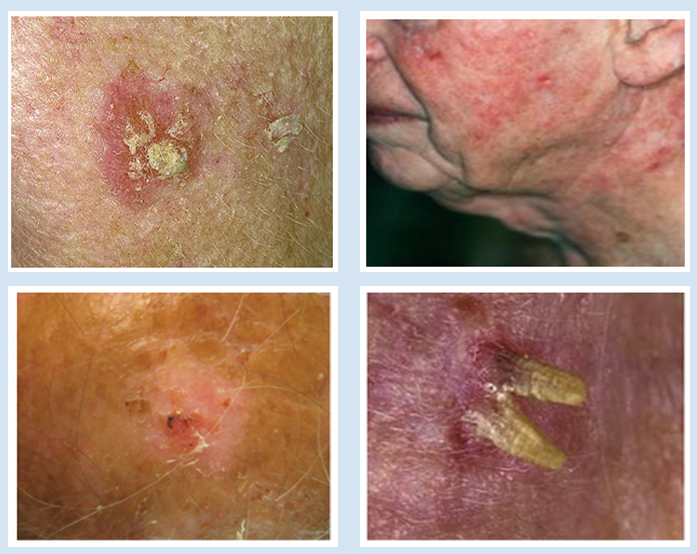Skin Condition » Sun spot
What is an actinic keratosis?
An actinic keratosis (AK), also known as a solar keratosis or a sun spot, is a small, rough spot occurring on skin that has been chronically exposed to the sun. Actinic keratosis generally measure in size between 2-6 millimeters in diameter (between the size of a pencil point and that of an eraser). They are usually reddish in color, with a rough texture and often have a white or yellowish scale on top. Actinic keratosis often occurs against a background of sun damage. It is precancerous (premalignant), which means it can develop into skin cancer. However, relatively few of them actually become cancer, a process that typically takes years. When a malignant change does occur, the cancer is called a squamous cell carcinoma. Treating actinic keratosis at an early stage helps prevent this possibility. There are other spots, called seborrheic keratosis, which is not caused by sun exposure and have no relationship to skin cancers. These are raised brown lesions that may appear on any area of the skin. They also often run in families.
Where on the body do actinic keratoses typically occur?
Common locations for actinic keratoses are the face, especially the cheeks and bridge of the nose, scalp, back of the neck, upper chest, as well as the tops of the hands and forearms. Men are more likely to develop AKs on top of the ears, whereas women's hairstyles often protect this area. AKs, especially on the scalp and the backs of the hands, may be hypertrophic (thickened skin).
The best treatment for an AK is prevention
Fortunately, there are several effective treatment methods to remove AK
• Cryosurgery: Freezing AKs with liquid nitrogen often causes them to slough off and go away.
• Laser surgery: AK can be treated by using ablative CO2 laser
• 5-fluorouracil (5-FU): Creams containing this medication cause AKs to become red and inflamed before they fall off. Although effective, this method often produces unsightly and uncomfortable skin for a period of weeks, thus making it impractical for many patients. This method is best for patients who have a great deal of sun damage and many AKs. Once the skin heals, it often looks much smoother and even-toned, in addition to having fewer actinic keratoses.
• Imiquimod (Aldara): This immune stimulator is similar in its indications and effects to 5-FU.
• Photodynamic therapy (PDT): This therapy involves applying a dye (aminolevulinic acid [Levulan] or ALA) that sensitizes the skin to light, leaving it on for about one hour, and then exposing the skin to light that activates the dye. This light can come from a laser or other light source. Like 5-FU and imiquimod, photodynamic therapy works best for patients with many AKs. Patients need to avoid exposure to sun or intense fluorescent light for two days after treatment to prevent ongoing peeling.
• Diclofenac (Solaraze): This cream is anonsteroidalantiinflammatory drug (NSAID), a popular medication for headaches. Diclofenac is gentler than 5-FU or imiquimod, causing less inflammation, but must be applied for a longer period of about two months to achieve benefits.

Solar lentigo
A solar lentigoor an age spot is a small pigmented spot on the skin with a clearly-defined edge, surrounded by normal-appearing skin. It is a harmless abnormal growth and distribution of melanocytes which is linear in its spread. This means the overlying of melanocytes is restricted to the cell layer directly above the basement membrane of the epidermis where melanocytes normally reside. This is in contrast to the "nests" of multi-layer melanocytes found in mole. Because of this characteristic feature, the adjective "lentiginous" is used to describe other skin lesions that similarly proliferate linearly within the basal cell layer.
Lentiginesbased on the increase in a number of melanocytes are distinguished from freckleswhich have a relatively normal number of melanocytes but an increased amount of melanin. Freckles will decrease in number and darkness if avoidance of sunlight exposure, whereas lentigines will stay stable in their color.
Doubled wavelength of MedliteC6 Nd YAG laser has been used to target superficial pigments and get rid of both freckles and solar lentigo.
Call Center : +66 618240996
Line ID : laserpremium